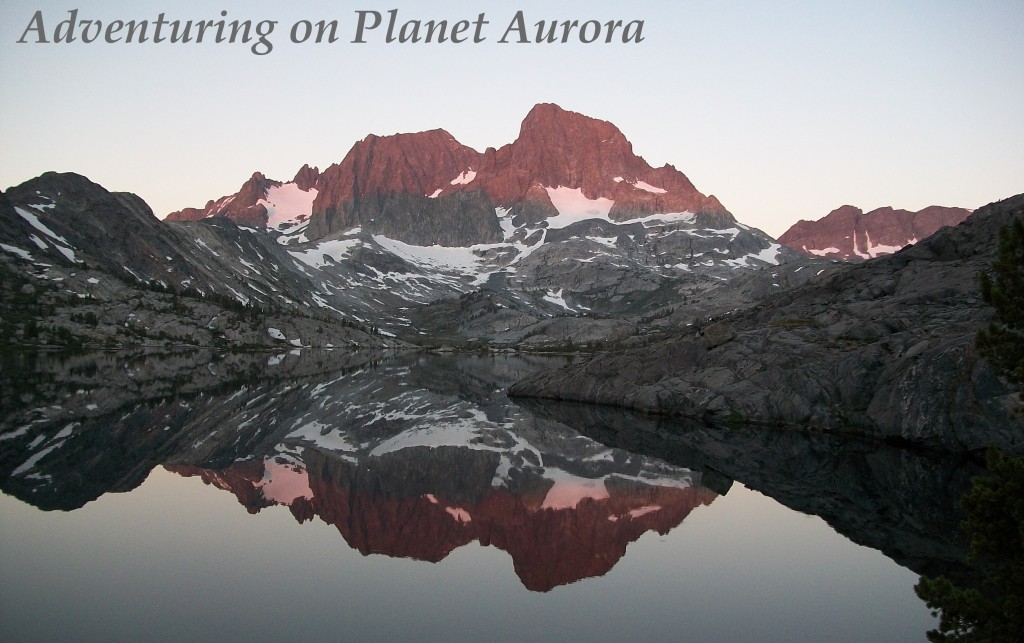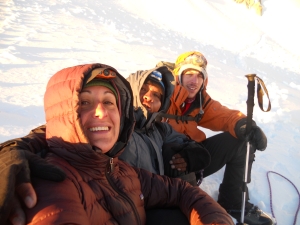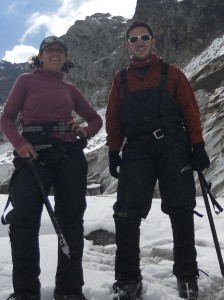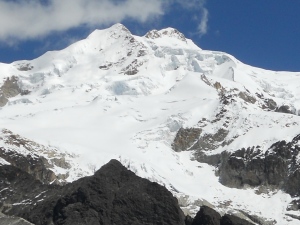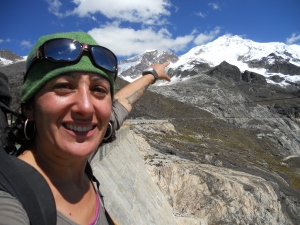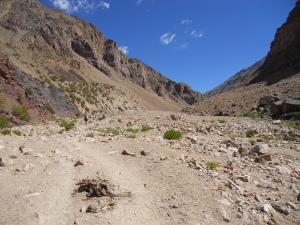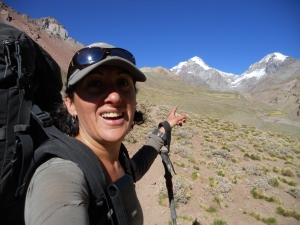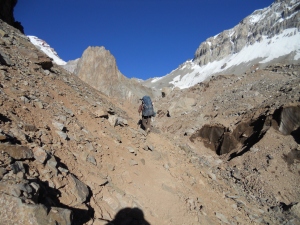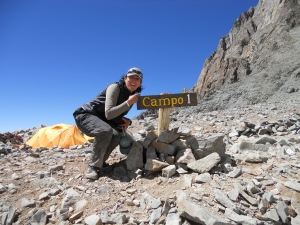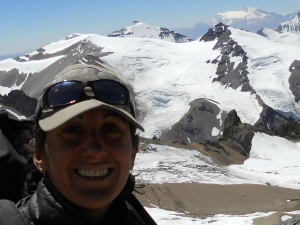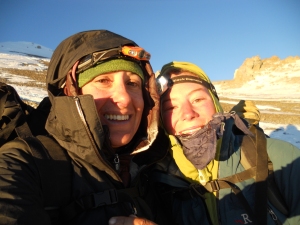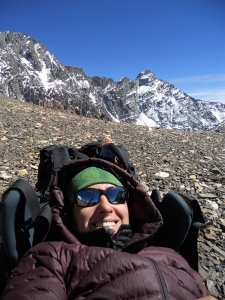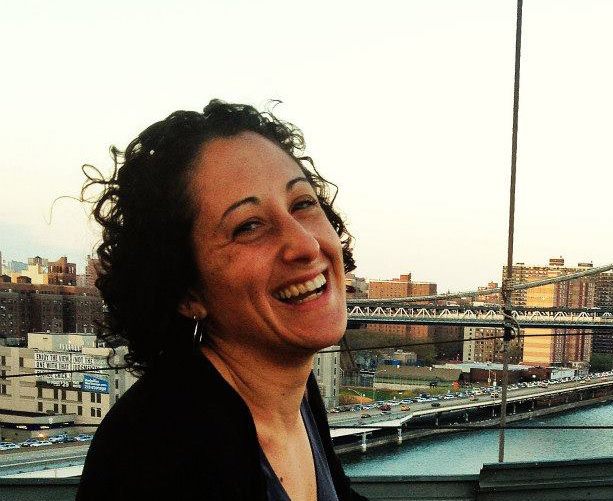Gettin’ my climb on
As I have told you all, Bolivia is the land of amazing geography — from salt flats, to one of the highest plateaus in the world to amazing mountain ranges, Bolivia seems to have it all. Among mountaineers, Bolivia is well known for the Cordillera Real (the Royal Range) – home of some of the highest mountains in Bolivia, many of them over 6,000m.
[side note for all my American readers — I know that we are still stuck in the world of feet and inches and pounds and gallons, alone in the world, sticking to our guns… er, measurements. But, as you probably also know — the rest of the world has agreed to all use the same measurements, making it easy for everyone else to understand meters and celsius without needing to do quick math in their heads. My tactic? Just go with the crowd….]
In any case, if you know me, you know that I have a thing for mountains. Especially the big snow covered variety. And since every tour agency in La Paz offers a climb to Huayna Potosi, I decided to investigate. Turns out that I could take a guided climb for 3 days and try for the summit, 6,088m. I spent a while talking to one tour agency run by a Bolivian doctor who is also a climber (and starting some studies on high altitude health). We had some fun talks about mountains and though he was quirky (to put it mildly), I felt pretty good about the agency and decided to sign on. It took a few days for their to be a group for the day(s) I wanted, but finally it looked like it was a go as one other person signed up for the day I wanted to go!
Now, I have never done a guided climb before, being the guide myself or going with friends. But, not having any firends here to go with, it makes it a whole lot harder to go climbing. I tend to not love guided trips – as I do not like people waiting on me and I always want to help – which makes them uncomfortable (as that is not how it is done). But, as one friend pointed out, how nice would it be to show up and have all the food already taken care of? Good point.
In any case, our group of 3 — Feliciano — our guide, Elad — an Israeli navy lieutenant traveling in South America for 4 months after his 7 years of service, and myself, headed up to the mountain. Feliciano, who is 40, has been spending time in the mountains since he was 14 and has been a guide for 16 years. He has climbed all the mountains in Bolivia, and most major peaks in Peru, Argentina and some in Ecuador. We had fun talking about Aconcagua (he has climbed all the routes there — which is super impressive!)
The refugio we were staying at the first night was pretty close to La Paz — just 14 or so km from the city boundary. After arriving and eating lunch, we headed up to the glacier for snow school — which was pretty much just learning how to use an ice axe, walk with crampons and play on the snow. Technically, I probably did not need this day as walking in crampons is something I feel pretty confident with — but at the same time, it was nice to go out their with the guide and feel confident about their skills and their method of teaching. And, I will always take a day to go play in the snow!
In any case, before I bore you non-mountaineering-types with stories of snow and ice, the schedule was to get as much sleep as possible the first day and then to head up to the high camp the next day (which can take our guide close to 40-50 minutes, but took us about 3 hours – but more on that later), eat dinner there and then try and get a few hours of sleep before waking at midnight to head up to the summit (anywhere from 4-8 hours).
The walk to high camp was beautiful — though cloudy. But we got some great views of the glacier, distant peaks and the valley below. Plus Huayna Potosi is a beautiful mountain (see for yourself).
I would not say that I am in the best shape of my life — exercise has been intermittent, coffee and brownies are indulged in on a regular basis (‘oh, just a little treat for myself’), Bolivia hasn’t been super kind to my digestive system and every hostel I stay in seems to have a gazillion smokers. But, I tend to do well at altitude and my strength has always been in my ability to walk up hills for hours, albeit slowly. This trip proved to be the same, and though I don’t feel like I am in the best shape ever, I am definitely more in shape in comparison to other tourists. And when you are in a group, you know who’s speed you walk at……
The high camp refugio was small, basically a shack with a kitchen — an upper and lower bunk where at least 12-18 could sleep (if you were really crowded in). Us 3 showed up early, but then a group of 5 Israelis, 1 Dutch girl (the only other girl around), and their 3 guides showed up — making it a home for 12. After an early dinner of ramen noodles and hot dogs ((I know you are jealous), we tried to go to sleep at 6:30 for our midnight wake-up call. Between nerves (I am always nervous before a climb — just ask my climbing partner how I did the afternoon we spent staring at the west face of shasta before we climbed it!), listening to a roomful of snoring boys, and how hot a tiny shack can get with 12 bodies crammed into it — all I could do was rest my body as my watch registered the hours (and yes — I heard them all from 7 until 11, at which point I resigned myself to pulling an all-nighter – which of course lead me to try and remember the last time I pulled an all-nighter… but I digress).
Alpine starts are one of my favorite things about mountaineering. I don’t know why, there is just something so cool about waking up before everyone else and heading up the mountain. I love climbing in the dark – seeing the stars, faint outlines of the mountain before me and the sight of headlamps making their way up the mountain. And the reward for that? Seeing the sunrise from high up on the mountain.
This time was no different. We started off at 1:40 (following a cluster in the refugio as tired folks struggled to put on harnesses, plastic boots, and crampons — new for most of them) with Feliciano leading us up the mountain, followed by Elad and then myself. Though the climb was really hard for Elad, I was really impressed with his ability to steadily keep moving. Others (the other climbing party) were struggling — frequently throwing themselves to the ground desperately needing a break. But Elad really pushed himself and kept moving. Though we started at least half an hour after the other climbing teams (each rope team had two clients and one guide), we quickly caught up with them and leap-frogged with them for the rest of the climb.
It was a beautiful night, not a cloud in sight, fairly warm and no winds. In other words, a perfect climbing night. The snow was crisp, if just a bit sugary, and the climb was fairly straight forward. We snaked past some gaping crevasses and climbed a pretty awesome 45 degree slope over a crevasse (front pointing is ALWAYS fun!). The approach to the summit was steep and exposed, with the finally approach along the ridge to the small summit (that dropped off to the extremely steep west face). It was probably one of the more exposed climbs I have done, which was fine on the ascent, a bit spookier on the descent (requiring full attention which is why I unfortunately do not have any pictures of it).
We arrived at the summit just in time for the sunrise, which did not fail to impress. Mountains in all directions glowing from the rising sun and the pink clouds below us. But, in mountaineering, the summit is just a small part of the journey, so we took some pictures (weak shots as there was not enough light) and then headed down in increasing day light. I was astounded as we descended at how beautiful it was — Bolivia at that moment owning my heart (sorry Patagonia, India and Nepal).
Our descent was fairly quick and involved some fun ‘skiing’ down some slopes (once we were past the glaciers) and we arrived back at the lower refugio in time for an early lunch and our ride back to La Paz. My second highlight of the day? Playing with the concinera (cook’s) daughter. She was adorable, I only understood about a third of what she said (ok, make that 1/8th, so I just said ‘no se’ a lot), but we had so much fun playing outside!
Feliciano, seeing my skills and knowing that I had climbed before, offered to guide me up other mountains if I wished. We spoke last night (my first spanish conversation on the phone!) and then texted today and I decided to try for Illimani later this week. It was a bit of a spur of the moment decision as he texted me saying I needed to decide quickly as he was headed back up the mountain with another group today. There were plenty of reasons to say no (money, spending more time in La Paz since we cannot go until Friday, money and more money), but then again — when will I get a chance to climb the second highest peak in Bolivia with a private guide?!
I’m a little nervous (when am I not?) as this peak is higher, a bit more technical and potentially longer. But, I guess that is why I have a guide! And, I’ll tell you what, it felt damn good to be up on a mountain again. I remembered that my goal on this adventure was to climb and trek as much as possible — and so this seems to be a good way to achieve my goals! So now, I am going to try and figure out how to entertain myself and not spend a lot of money for the next few days!
